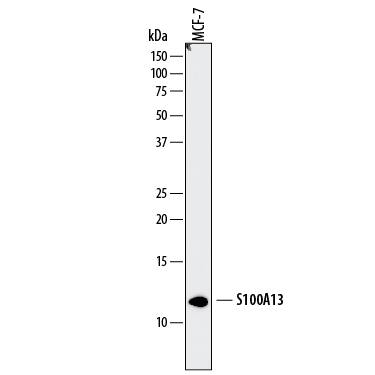Human S100A13 Antibody
R&D Systems, part of Bio-Techne | Catalog # MAB4327

Key Product Details
Species Reactivity
Applications
Label
Antibody Source
Product Specifications
Immunogen
Ala2-Lys98
Accession # Q99584
Specificity
Clonality
Host
Isotype
Scientific Data Images for Human S100A13 Antibody
Detection of Human S100A13 by Western Blot.
Western blot shows lysates of MCF-7 human breast cancer cell line. PVDF membrane was probed with 2 µg/mL of Mouse Anti-Human S100A13 Monoclonal Antibody (Catalog # MAB4327) followed by HRP-conjugated Anti-Mouse IgG Secondary Antibody (Catalog # HAF007). A specific band was detected for S100A13 at approximately 11-12 kDa (as indicated). This experiment was conducted under reducing conditions and using Immunoblot Buffer Group 1.Applications for Human S100A13 Antibody
Western Blot
Sample: MCF‑7 human breast cancer cell line
Formulation, Preparation, and Storage
Purification
Reconstitution
Formulation
Shipping
Stability & Storage
- 12 months from date of receipt, -20 to -70 °C as supplied.
- 1 month, 2 to 8 °C under sterile conditions after reconstitution.
- 6 months, -20 to -70 °C under sterile conditions after reconstitution.
Background: S100A13
S100A13 is an 11 kDa member of the S100 (soluble in 100% saturated ammonium sulfate) family of vertebrate EF-hand Ca++-binding proteins (1‑3). It is widely expressed as a homodimer with two 98 amino acid (aa) long subunits (2, 3). Human S100A13 shares 83%, 90%, 91%, 87%, 78% and 47% aa identity with mouse, rat, cow, dog, opossum and chicken S100A13, respectively. Like other S100 proteins, S100A13 is small and generally acidic, but contains a basic residue-rich sequence at the C terminus, and two EF hand motifs that bind with Ca++ differing affinities (2‑4). Some S100 proteins, including S100A13, are able to bind the cell surface receptor for advanced glycation end-products (RAGE) (5). Despite lacking a signal sequence, S100A13 plays an important role in Cu++-dependent export of FGF-1 (FGF acidic) and IL-1 alpha from the cell in response to stresses such as heat shock, anoxia and starvation (6‑8). Binding of copper is necessary for formation of a multi-protein complex between S100A13, FGF-1 and p40 synaptotagmin-1 (syt-1) (9, 10). Cu++ ions supplied by S100A13 are thought to oxidize and downregulate the activity of FGF-1 prior to export (10). Calcium influx may also play a similar role in FGF-1 release from neuronal cells (11). S100A13 is composed of four amphiphilic helices that may interact with acidic phospholipid headgroups. With FGF-1 and syt-1, S100A13 likely perturbs the membrane, which allows the S100A13 protein complex to exit the cell (4, 12). S100A13 has been proposed as a marker for angiogenesis in tumors and endometrium, due to its role in stress-induced export of FGF-1 (13, 14). Based on in house studies, S100A13 has also been found to promote neurite outgrowth from rat cortical embryonic neurons (15).
References
- Santamaria-Kisiel, L. et al. (2006) Biochem. J. 396:201.
- Wicki, R. et al. (1996) Biochem. Biophys. Res. Commun. 227:594.
- Ridinger, K. et al. (2000) J. Biol. Chem. 275:8686.
- Li, M. et al. (2007) Biochem. Biophys. Res. Commun. 356:616.
- Hsieh, H.-L. et al. (2004) Biochem. Biophys. Res. Commun. 316:949.
- Landriscina, M. et al. (2001) J. Biol. Chem. 276:22544.
- Sivaraja, V. et al. (2006) Biophys. J. 91:1832.
- Mandinova, A. et al. (2003) J. Cell Sci. 116:2687.
- Prudovsky, I. et al. (2002) J. Cell Biol. 158:201.
- Landriscina, M. et al. (2001) J. Biol. Chem. 276:25549.
- Matsunaga, H. and H. Ueda (2006) Cell. Mol. Neurobiol. 26:237.
- Graziani, I. et al. (2006) Biochem. Biophys. Res. Commun. 349:192.
- Landriscina, M. et al. (2006) J. Neurooncol. 80:251.
- Hayrabedyan, S. et al. (2005) Reprod. Biol. 5:51.
- R&D Sytems (2007) In-house data.
Long Name
Alternate Names
Gene Symbol
UniProt
Additional S100A13 Products
Product Documents for Human S100A13 Antibody
Product Specific Notices for Human S100A13 Antibody
For research use only
